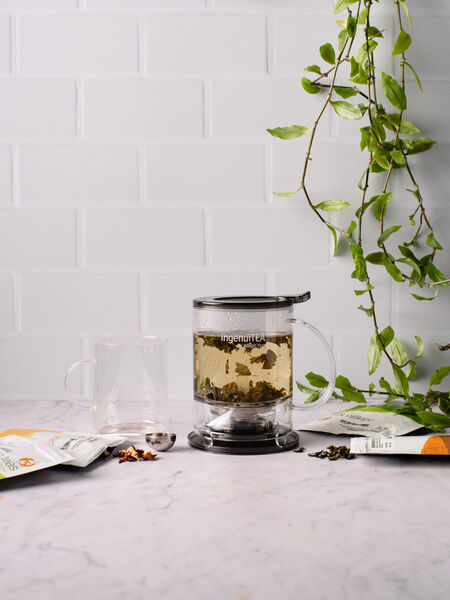French Tea Culture and Creating A Le Goûter


For Anglophiles and devotees of British-style afternoon tea, it’s a delicious reminder to share that French tea was, and is, a lovely conduit for socializing and solo relaxation. The tea experience in France is hardly new, as tea was first introduced to the royal court in 1636, its first tea café opened in 1671 in Marseilles followed by a second one which opened in 1686 in that venerable city of sophistication, Paris.
History of French Tea Culture
The French embraced tea first for health, then for pleasure.
Historical references indicate that tea in France was first used as a medicine (as it was throughout the world) before evolving into its signature place among social gatherings among the elite, then the masses.
French botanist-physician Denis Joncquet (1600-1671) was part of the growing numbers of scientists, botanists, physicians, and pharmacists throughout Europe espousing tea as a great elixir of health describing tea as “ambrosia” and the plant from which it came as that “divine herb.” Philippe Sylvestre Dufour (1622-1687) published one of the first books in French to seriously discuss tea, in 1685. Dufour extolled tea’s medicinal virtues along with other burgeoning beverages in “Traités Nouveaux et Curieux du Café, du Thé et du Chocolat” (“New and Curious Treatises on Coffee, Tea, and Chocolate.”)
Prolific (and charming) letter writer, Madame de Sevigne (Marie de Rabutin-Chantal, 1626-1696) shared reams on the gossip, and customs, of the day, once describing salon hostess, Marguerite de la Sablière, who “took tea with her milk,” allegedly the first mention of milk and tea together.
By the 18th century, French trader-explorers were venturing to the Far East to gather teas directly from the source, China. One of the first successful trading ships, Amphitrite, arrived in France on August 3, 1700 with the typical silks and porcelains, and tonnes of tea to satisfy members of the aristocracy.
Princess of the Palatinate aka La Palatine (1652-1722,) the sister-in-law of Louis XIV, disdained the use of coffee, chocolate, and tea. In one of her thousands of letters, where she chronicled dramas high and low of the court of Versailles, she wrote, “I find that tea tastes of hay and rotten straw, coffee of soot, and chocolate is too sweet and soft.” Yet, her keen eye for social trends recognized tea to be “as fashionable in Paris as chocolate was in Spain.” The princess, born in Germany as Elizabeth Charlotte of Bavaria, much preferred beer or hot wines.
The French Revolution (1789-1799) upended much in the country, but one absolute benefit is that the upper echelon was no longer the only tea-drinking demographic, the bourgeoisie were happily adapting the custom of le thé.
Le Goûter: Modern French-Style Tea
The royal rulers are long gone, replaced by the French Republic; le cafés are as ubiquitous by the seashore as they are in the cities, and herbal brews (tisanes) are enormously popular, and le goûter has become a charming mini-meal with tea enjoyed as a late afternoon pick-me-up for adults and after-school treat for children in a culture that (allegedly) eschews snacks.
For the children, le goûter is usually bread with the French equivalent of American peanut butter, Nutella, a chocolate-hazelnut spread; crêpes with chocolate or fresh berries and cream, or a pain au chocolat (triangular-shaped chocolate pastry.)
For adults, le goûter is a light meal to help one last until dinnertime generally served around 8 p.m. More substantial than the children’s version, it can include savories and sweets (chocolate croissants, a meringue cookie like macarons, or fruit tartes,) accompanied by tea or, mon dieu, coffee. Or, for those who like a little alcohol, apéritif accompaniments like nuts and olive spreads like tapenades.
Create Your Own Le Goûter
For your at-home version, let your imagination soar. Do serve the meal on your finest china plates and prettiest cups and saucers. Crystal glasses for the champagne or sherry will add a restorative elegance to the relaxing drink after a long work day. As a French press-style touch for brewing tea, Adagio’s ingenuiTEA, is a charming way to serve co-workers or friends with choices for teas and tisanes.
This petite meal lends itself wonderfully to creative menus based on three small courses of savories, sweets, and several beverages: one or two choices of tea, champagne or a liqueur. For your perfect at-home le goûter, choose among these suggestions or add your own French menu selections to the tea table:
Le Menu Suggestions
- Teas and Tisanes:
- Tisanes/Herbals: Lavender Lemon or Peach Serenity
- Teas: Or your favorite Assam, Darjeeling, or Keemun black tea
Optional: Champagne or Sauternes (dessert wines); Mimosa with Cointreau (orange liqueur) or Sidecar with Calvados (apple brandy)
- Savories:
- French Onion Soup or Vichyssoise (potato leek soup, served chilled)
- Quiche Lorraine (bacon and cheese pie or other savory pie)
- Salade Niçoise with tuna, olives, and anchovies or Salade Rachel with truffles, artichokes, boiled potatoes, asparagus, and mayonnaise
- Gruyere Toasts or Crackers with Olive tapenade
- Toasted slices of baguettes, a selection of French cheeses, and accompaniments like nuts, dried fruits, jams or chutneys
Of course, we have to end the light meal on something light and sweet!
- Sweets:
- Madeleine cookies or sponge cake with Mandarin orange segments
- Individual berry tarts, tarte tatin (apple tart) or baked apple slices
- French Macarons or petit fours (bite sized cakes)
- Individual chocolates or truffles
Should you be an invited guest, a beautifully-presented box of pastries or chocolates would be welcomed and, always, something home-made is a charming alternative, if time permits. Bring gossip, albeit kind and amusing, to make a fun contribution to the gathering.
Bon Appetit!
NOTE: Le goûter is also the French verb for “to taste” and is pronounced leh goo tay.
